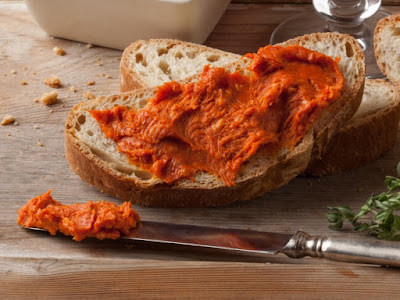Previously on Name This Food I asked what this was...
 |
| Anyone that answered "bread with stuff on it", see me after class. |
The red substance in the picture is a delicious spicy substance called 'Nduja.
'Nduja is a particularly spicy, spreadable pork salumi from Italy. It is a Calabrian variation of salumi,loosely based on the French andouille introduced in the 13th century by the Angevins.
The name 'nduja is linked to two other particular types of sausages made of meat and spices , the Piedmontese salam dla doja and the French andouille, from which the ' nduja takes its name. All these terms derive from the Latin "inductilia" ("things ready to be introduced", to "induce").
'Nduja is made using meat from the head (minus the jowls, which are used for guanciale), trimmings from various meat cuts, some clean skin, fatback, and roasted hot red peppers which give 'nduja its characteristic fiery taste. 'Nduja originates from the southern part of Calabria, namely from the small town of Spilinga and its neighborhood. It is mainly served with slices of bread or with ripe cheese. Its unique taste makes it suitable for a variety of dishes. For example, it can be added to pasta sauces.
From 1975 to today, on the 8th of August of every year in Spilinga the festival of the 'nduja (Sagra della 'nduja) is held. Similar events are held in many other Calabrian municipalities.
So - what do we do with it?
Here's a recipe for linguine with 'nduja and tomatoes from the brilliant Nigel Slater.
Bring a deep pan of water to the boil, salt it, then add 250g linguine and cook it for 8 or 9 minutes, until the pasta is tender.
While the linguine cooks, make the sauce: in a shallow pan – one to which nothing will stick – warm 140g of nduja over a moderate heat, stirring it regularly.
Slice 300g of cherry tomatoes in half then fold them into the warm nduja and continue cooking. Stir in 30g of cornichons, sliced in half lengthways, and 2 tsp of capers.
Leave to cook for 3 or 4 minutes until the tomatoes have started to give up some their juice. Then stir in 2 tbsp of olive oil.
Drain the linguine, then toss it with the sauce, folding the spiced tomatoes through the pasta.
The nduja sauce is very spicy. If you feel the need to tone down its heat, simply stir in more tomatoes, halved or crushed or as you serve the dish, and fold in a spoonful of yogurt or cream.
Nduja burns easily, so keep the heat moderate while it warms, and stir regularly to prevent it from scorching.
Instead of using pasta, the spiced tomato sauce can be spooned on to thick toast or bruschetta. Top the toast with a soft goat’s cheese, or a spoonful of goat’s curd or mascarpone. It is also good as a dressing for vegetables, such as baked courgettes, pumpkin or potatoes.
Here's one from Inside The Rustic Kitchen (insidetherustickitchen.com)
Cream Cheese and ‘Nduja Bruschetta
Author: Emily Kemp
Ingredients
4 slices of crusty bread
4 tbsp cream cheese good quality
4 tbsp 'Nduja
Pepper to season
Basil to garnish if desired
Instructions
Heat the grill and toast the slices of bread on one side.
Spread each untoasted side generously with cream cheese and dollop around 1 tbsp of 'Nduja on top of the cream cheese. Use less 'Ndjua for less heat.
Place back under the grill until the 'Nduja is sizzling, around 30 seconds.Sprinkle with pepper and scatter over some chopped basil if desired and enjoy.
Now then...
 |
| Name This Food! |



